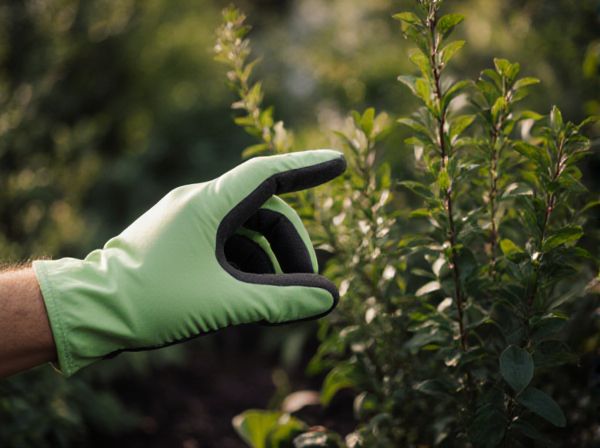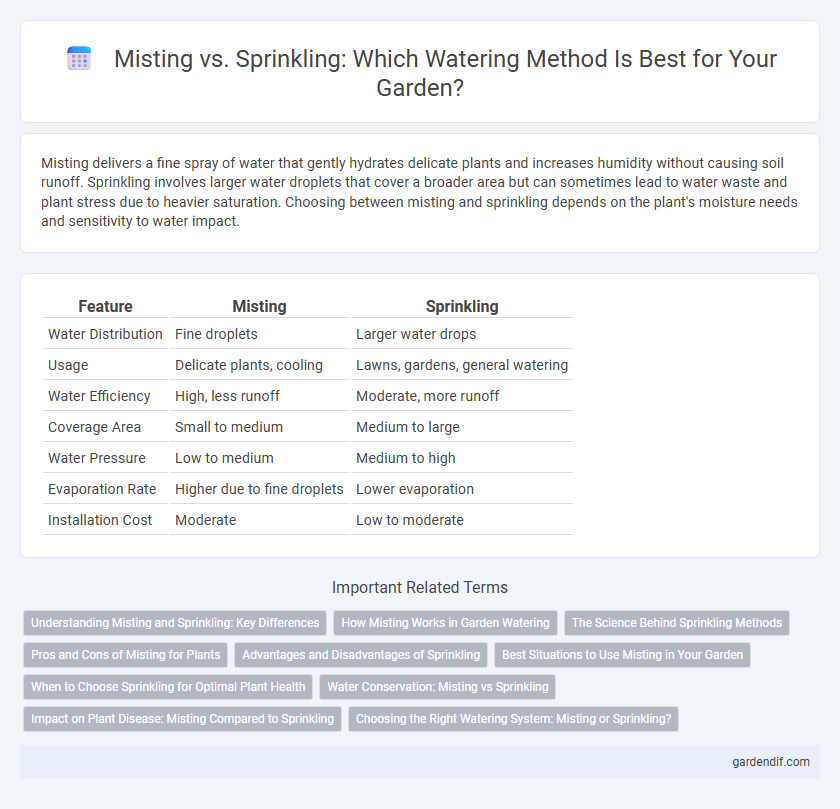
Misting vs Sprinkling Illustration
Misting delivers a fine spray of water that gently hydrates delicate plants and increases humidity without causing soil runoff. Sprinkling involves larger water droplets that cover a broader area but can sometimes lead to water waste and plant stress due to heavier saturation. Choosing between misting and sprinkling depends on the plant's moisture needs and sensitivity to water impact.
Table of Comparison
| Feature | Misting | Sprinkling |
|---|---|---|
| Water Distribution | Fine droplets | Larger water drops |
| Usage | Delicate plants, cooling | Lawns, gardens, general watering |
| Water Efficiency | High, less runoff | Moderate, more runoff |
| Coverage Area | Small to medium | Medium to large |
| Water Pressure | Low to medium | Medium to high |
| Evaporation Rate | Higher due to fine droplets | Lower evaporation |
| Installation Cost | Moderate | Low to moderate |
Understanding Misting and Sprinkling: Key Differences
Misting releases fine water droplets to increase humidity and gently hydrate delicate plants, while sprinkling disperses larger water drops for deeper soil penetration and broad coverage. Misting is ideal for seedlings, tropical plants, and indoor environments where moisture control is essential. Sprinkling suits lawns, gardens, and outdoor landscapes requiring efficient watering and soil saturation.
How Misting Works in Garden Watering
Misting in garden watering involves spraying fine water droplets that gently settle on plant leaves and soil, promoting moisture absorption without oversaturation. This method enhances humidity and reduces water runoff, making it ideal for delicate plants and seedlings. By delivering water as a fine mist, it minimizes evaporation and ensures efficient hydration in warm or dry climates.
The Science Behind Sprinkling Methods
Sprinkling distributes larger water droplets that penetrate soil more effectively, promoting deeper root hydration and reducing evaporation compared to misting. The kinetic energy of droplets in sprinkling enhances soil aeration and nutrient absorption, optimizing plant growth. This method leverages gravity and droplet size to maintain soil moisture balance, critical for sustainable irrigation practices.
Pros and Cons of Misting for Plants
Misting provides fine droplets that help increase humidity and gently hydrate delicate plants without overwatering, making it ideal for tropical and indoor species. However, misting may not deliver sufficient moisture to the root zone and can promote fungal diseases if overused in poorly ventilated environments. Compared to sprinkling, misting conserves water and reduces runoff but is less efficient for large outdoor gardens requiring deep soil irrigation.
Advantages and Disadvantages of Sprinkling
Sprinkling offers advantages such as covering large areas efficiently and providing deep soil moisture, ideal for lawns and gardens needing thorough hydration. However, disadvantages include potential water wastage due to evaporation and runoff, as well as increased risk of fungal diseases from prolonged leaf wetness. This method is less suitable for delicate plants that prefer direct soil watering or require controlled moisture levels.
Best Situations to Use Misting in Your Garden
Misting is ideal for delicate plants, seedlings, and indoor gardens that require gentle hydration without waterlogging the soil. It helps maintain high humidity levels, which is essential for tropical plants and orchids to thrive. Use misting during hot, dry weather to prevent leaf damage and promote healthy growth without over-saturating the garden.
When to Choose Sprinkling for Optimal Plant Health
Sprinkling is ideal for thoroughly irrigating larger garden areas or lawns where deep soil penetration is necessary to promote strong root growth and overall plant health. It effectively distributes water uniformly across expansive landscapes, preventing dry spots that can lead to uneven growth and stress in plants. Use sprinkling during cooler parts of the day to reduce evaporation and minimize fungal diseases commonly associated with excessive moisture on foliage.
Water Conservation: Misting vs Sprinkling
Misting uses fine water droplets that minimize runoff and evaporation, making it highly efficient for water conservation compared to sprinkling. Sprinkling delivers larger water droplets that often cause runoff and water loss due to wind drift and soil saturation. Optimal water conservation is achieved through misting, especially in arid regions or during peak sunlight hours where water evaporates rapidly.
Impact on Plant Disease: Misting Compared to Sprinkling
Misting creates a fine, consistent moisture layer on leaves that can increase humidity and promote fungal diseases like powdery mildew and downy mildew. Sprinkling delivers larger water droplets that quickly reach the soil, minimizing leaf wetness duration and reducing the risk of airborne pathogens. Choosing sprinkling over misting often results in healthier plants by limiting favorable conditions for disease development.
Choosing the Right Watering System: Misting or Sprinkling?
Misting systems deliver fine water droplets, ideal for delicate plants and maintaining humidity, while sprinklers cover larger areas with heavier water flow suitable for lawns and sturdy vegetation. Selecting the right watering system depends on plant type, water needs, and environmental conditions; misting conserves water by targeting foliage, whereas sprinkling ensures ground saturation. Efficient irrigation balances water usage with plant health, making it essential to match the system to specific garden requirements.
Misting vs Sprinkling Infographic

 gardendif.com
gardendif.com